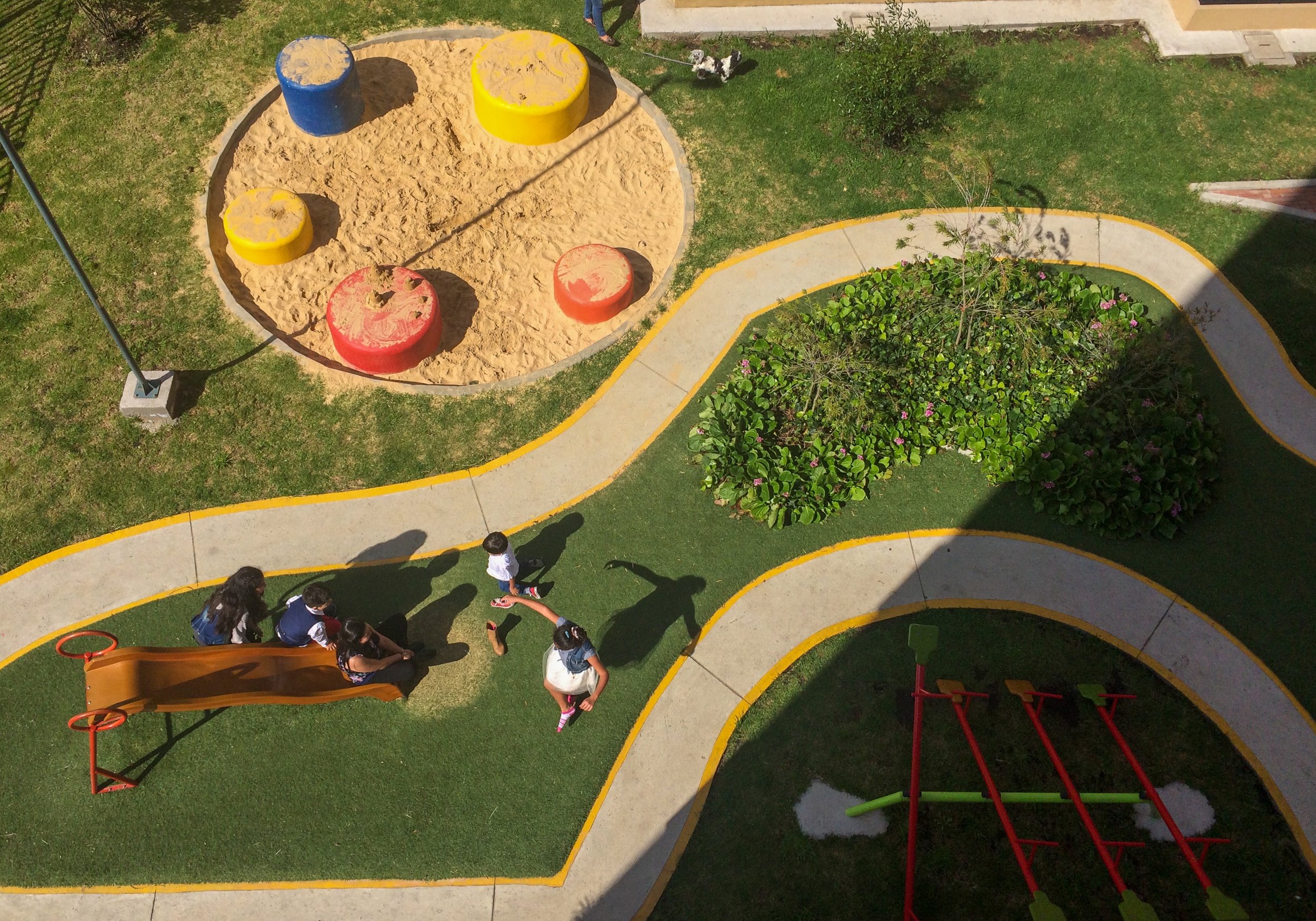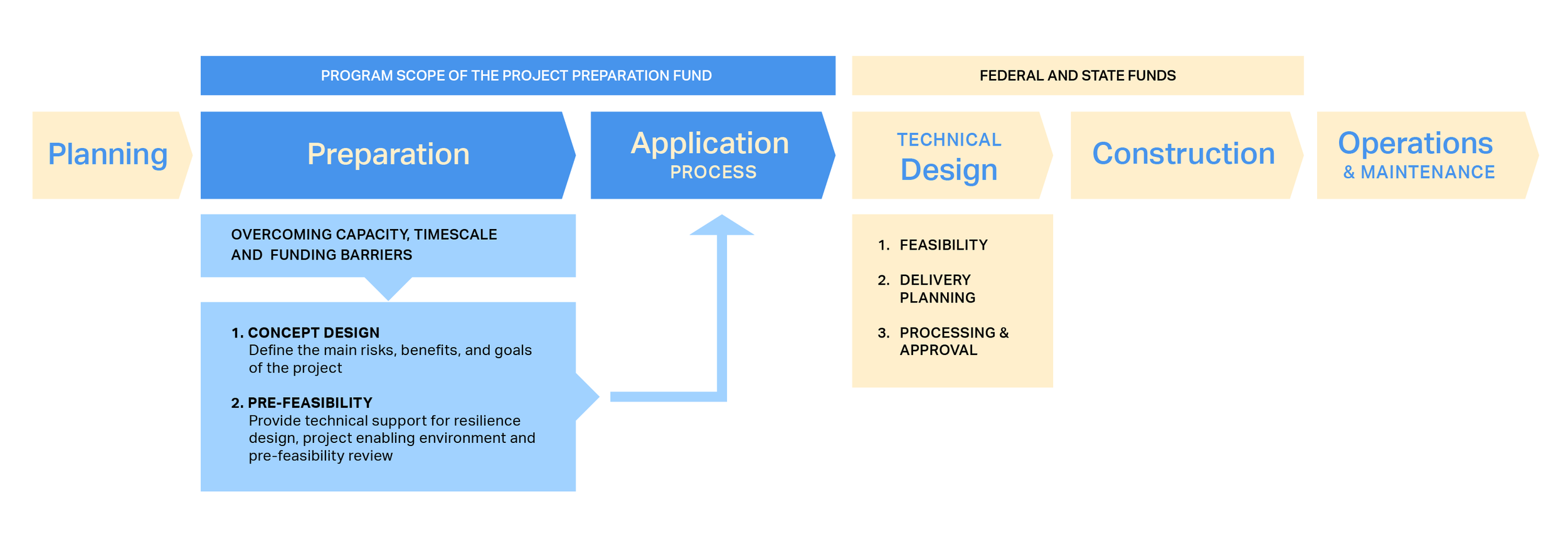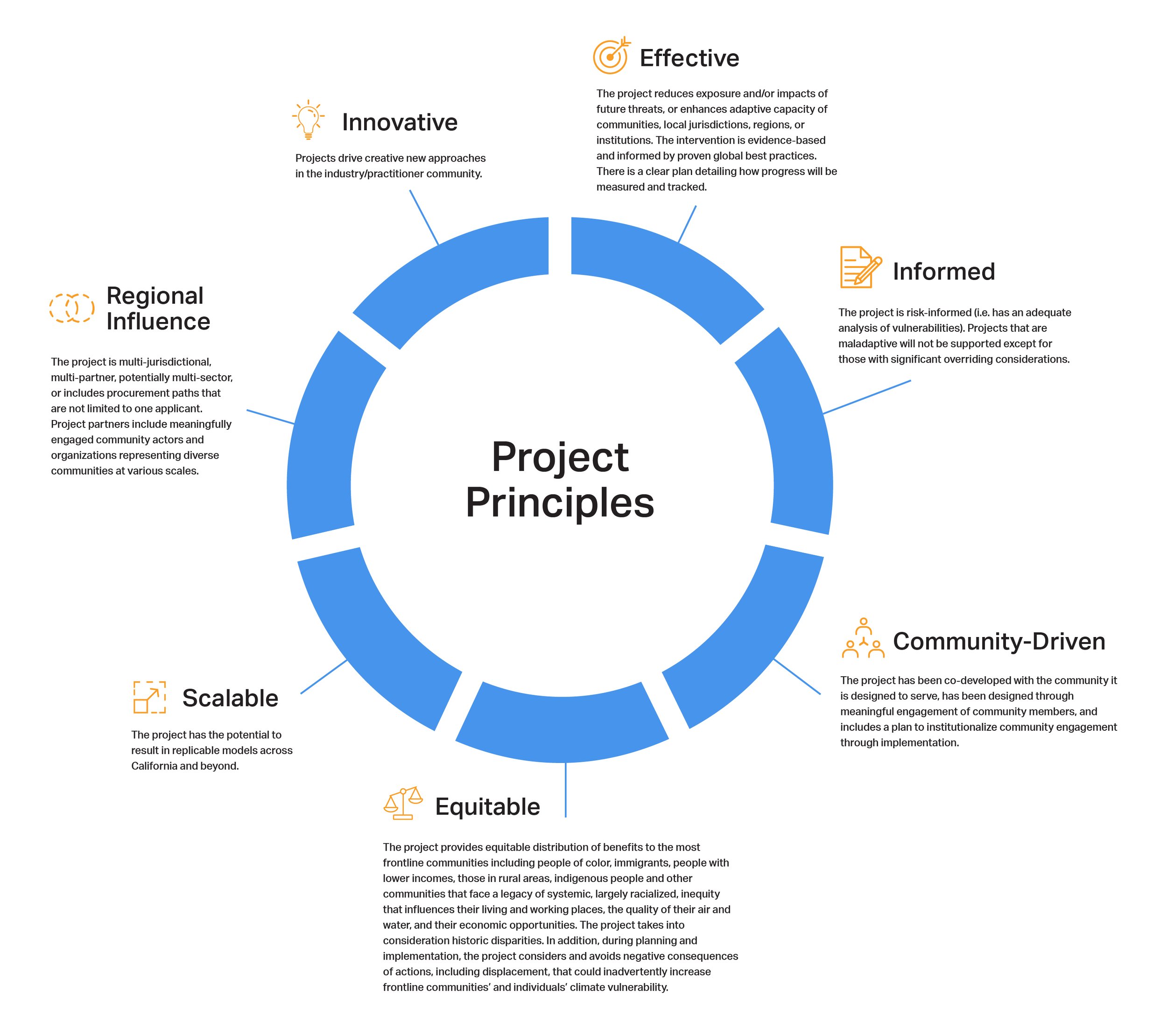
OVERVIEW
The California Resilience Partnership’s Project Preparation Program (CRP-PPP) will support communities in advancing infrastructure projects that build equity and resilience and show great promise for community impact by preparing these projects to capitalize upon unprecedented levels of federal and state funding.
The passage of the federal Bipartisan Infrastructure Law and Inflation Reduction Act, and of California’s historic 2021 and 2022 State budget, have unlocked a once in a generation amount of federal and state resources to support critical infrastructure investments. The need for these investments has never been more urgent, as communities across the state face mounting existential climate risks and historic inequality only exacerbated by the pandemic. The CRP Project Preparation Program aims to ensure that communities most in need of these investments can overcome barriers and achieve inter-generalization impact.
Program scope within a typical infrastructure project cycle
The Program will identify promising, community-supported projects and work with partners and key stakeholders to:
Create Stronger Project Narratives
Incorporate Additional Equity and Resilience Benefits
Mitigate Obstacles to Success
Identify State and Federal Funding Sources, Including Options for Meeting Local Match Requirements
Build Lasting Capacity to Develop Future Projects
Project leaders from selected communities may receive:
Assistance on writing competitive grant applications
Technical design and cost-benefit analysis support from leading global design and build firms
Capacity support in producing materials to help secure project funding, including a concept note and roadshow
Support for community engagement, including through small grants
Technical support in incorporating global best practices in project design in a way that best supports community needs
This program is funded to cover the following activities:
Project level kick-off sharing current state of project detail
Project diagnosis and planning for in-person workshops
Project Agenda Setting Workshop
Enhancing the impact story: Maturing the project goals
Mapping and understanding the Funding landscape
Community stakeholder input and design
High-level project work plan
Deeper project definition through Direct Technical Assistance
Could include:
Preliminary Design Drawings
Cost benefit analysis
Improved costing estimates & funding strategies
Enhanced project-benefits
Enhanced and competitive project narrative and roadshow
Clear funding roadmap
Federal and State Grant writing support
Action plan for next phases of project
OVERVIEW
The California Resilience Partnership’s Project Preparation Program (CRP-PPP) will support communities in advancing the equity- and resilience-building infrastructure projects that show the greatest promise for community impact—and preparing these projects to capitalize upon unprecedented levels of federal and state funding.
The passage of the federal Bipartisan Infrastructure Law and Inflation Reduction Act, and of California’s historic 2021 and 2022 State budget, have unlocked a once in a generation amount of federal and state resources to support critical infrastructure investments. The need for these investments has never been more urgent, as communities across the state face mounting existential climate risks and historic inequality only exacerbated by the pandemic. The CRP Project Preparation Program aims to ensure that communities most in need of these investments can overcome barriers in accessing them.
Phasellus pharetra aliquet viverra. Donec scelerisque tincidunt diam, eu fringilla urna auctor at.
Phasellus pharetra aliquet viverra. Donec scelerisque tincidunt diam, eu fringilla urna auctor at.
Phasellus pharetra aliquet viverra. Donec scelerisque tincidunt diam, eu fringilla urna auctor at.
ELIGIBILITY

We are pleased to invite local and regional public entities, non-profit organizations, and community based organizations that own and are preparing to implement climate- and equity-focused infrastructure projects. We will select the inaugural projects based in the Greater Los Angeles and Sacramento regions in California. If you would like to submit a project for the program, please use the ‘Nominate a Project’ tab.
Please view the program eligibility criteria below before nominating a project.
For more information on community eligibility and tools to help identify vulnerable communities that meet the criteria described above, please visit our FAQ.
PROJECT ELIGIBILITY
Project Size: The overall project cost must be between $5 million to $200 million
Infrastructure Component: The project must include an infrastructure component that serves under-resourced populations and the public at large as part of the design.
Beyond the Planning Stage: Projects aiming to develop climate action/resilience plans, hazard and feasibility studies, vulnerability assessments, and any other form of report/plan that does not involve a physical infrastructure component are NOT eligible.
Climate Change Component: The projects must address climate change through adaptive and/or mitigative measures.
Building Equity: The project must address community socio-economic inequities
Local Leadership Commitment: Local leadership is committed to this work and it's a local priority for state and/or federal funding.
Grounded in Community-based Planning: The project—or at least the general concept —has emerged from previous community-based planning efforts (like a general plan, resilience strategy, climate and resilience plans, or economic development plan).
In addition, project owners will aspire to incorporate the following principles as part of this process:
PROJECT LEADER ELIGIBILITY
Eligible project leaders include:
** State and Federal agencies are NOT eligible to apply for this program but can be a sub-contracted partner with a consortium of local public or non-profit entities.
APPLICATION REVIEW PROCESS

All applications will be reviewed by the Resilient Cities Catalyst (RCC) team, under the guidance of California Resilience Partnership's (CRP) Advisory Board.
The team will use the eligibility criteria outlined above to guide the selection of two pilot projects in the Greater Los Angeles and Sacramento regions by early November, 2022.
The timeline for the nomination and selection process is as follows:
Selected Project leaders will receive additional information about the project development process, including a kick-off and project initiation call. Please review the eligibility for selection and click on the ‘Nominate a Project’ tab to nominate a project for the program.
NOMINATE A PROJECT

Please complete the form below to the best of your knowledge and provide relevant documentation as indicated or needed.
You can also view our FAQ section and/or reach out to us at contact@rcc.city.
Please note: This form cannot be saved and hence needs to be completed in one sitting. So we encourage project leaders to navigate through the form, collect all the information prior to submitting a response.
The maximum size for each file upload is 15MB and the total size limit for the form is 100MB. In case, the attachments are of maximum file size, please be patient for the files to upload after clicking the 'submit' button and do not refresh the page or all changes will be lost.
FAQs

Are private projects eligible for this program?
How does this program define “underserved,” “vulnerable,” and “low-income” communities?
The CRP Project Preparation Program is leveraging definitions from the following resources. Project leaders may use definitions other than those provided below; if so, please provide relevant documentation in the “Additional documents” section of the form.
- “Disadvantaged communities” as defined by CalEnviroScreen 4.0 (Health and Safety Code Section 39711);
- “Low-income communities”, as defined under the AB 1550 ‘Identification of Low-Income Communities’;
- “Disadvantaged communities”, as defined by SB 535 and as per the California Office of Environmental Health Hazard Assessment;
- Frontline communities and underrepresented communities, which are those that experience continuing injustice—including people of color, immigrants, people with lower incomes, those in rural areas, and indigenous people; and
- “Climate vulnerable communities,” as defined in the Governor’s OPR resource, Defining Vulnerable Communities in the Context of Climate Adaptation.
Are there existing tools that can be leveraged to identify vulnerable populations in my community?
Yes. Project leads may use any of the following tools to identify Vulnerable Communities. This is a non-exhaustive list, showing some of the most common vulnerability assessment tools in California.
- CalEnviroScreen 4.0 by the Office of Environmental Health Hazard Assessment (OEHHA)
- CalEnviroScreen 4.0, Healthy Places Index (HPI)
- Regional Opportunity Index (ROI)
- Climate and Economic Justice Screening Tool (J40)
- CalADAPT, and/or Climate Change and Health Vulnerability Indicators (CCHVI)
Is it mandatory for projects to prioritize serving vulnerable populations?
How does the program define resilience?
What are ‘Shocks’ and ‘Stresses’?
A shock is a rapid-onset crisis or a severe climate event that has the potential to severely harm communities, systems, and natural ecosystems. Shocks are usually sudden and of a limited duration.
Examples include:
- Wildfire
- Earthquake
- Landslide
- Pandemic or public health emergency
- Extreme heat
- Tsunami
- Flooding
- Infrastructure failure
A stress is a chronic (ongoing or cyclical) natural or human-driven challenge that causes underlying or slow-burning harm to communities, systems, and natural ecosystems.
Examples include:
- Lack of affordable housing
- Poverty
- Systemic racism
- Aging or inadequate infrastructure
- Unemployment
- Homelessness
- Lack of social cohesion
- Economic inequality
- Sea level rise
- Grid vulnerabilities
- Invasive species
- Poor air quality
- Shifting macroeconomic trends
- Drought and water shortage
- Food insecurity
- Disparities in access to high-quality healthcare
- Disparities in access to high-quality education
- Environmental degradation
What are project ‘Co-benefits’?
Co-benefitsare defined as the capacity of projects and communities to leverage new and innovative socio-economic opportunities to reap multiple positive outcomes for the investment made beyond addressing the relevant shocks and stresses.


























